#Extinction
Text
A study that just came out demonstrates that outdoor cats are known to prey on over two thousands species of wild animal, from mammals to birds to insects. That includes 347 species that are endangered, threatened or otherwise of concern, and they've been a key factor of the permanent extinction of over 60 species. And while cats may not always bring home what they catch, chances are if your cat is allowed to roam unsupervised outside, they're killing your local wildlife.
Why is this so important? Worldwide, wild animal populations have decreased in number by 69% in the past fifty years; that means that in my lifetime (born in 1978), the sheer number of wild animals in the world has been decreased by over half. Even "common" wild species are less numerous than before. While habitat population is the single biggest cause of species endangerment and extinction overall, outdoor and indoor/outdoor cats are a significant cause as well. In fact, they are the single biggest cause of human-caused mortality in wild birds.
Most importantly, it's very, very simple to fix this problem: keep your cats indoors, and spay and neuter them. If your cat is bored, they need more enrichment, and there are plenty of ways to make your home more exciting for them, from bringing home cardboard boxes for them to explore, to playing with them more often. If you want your cat to get some outdoor enrichment, leash train them (yes, it can be done!) If you have the space and resources, build them a catio where they can be safe from outdoor dangers like predators and cars, while also keeping local wildlife safe from them.
If you just give into their whining and pawing at the door, then they know that that's what they have to do to get their way; I know it's a tough transition, but it's worth it in the end for everyone involved. Cats are domesticated, which means they are not native anywhere in the world; there are exactly zero ecosystems in which they belong, save for the safety of your home. It is your responsibility to give them an enriching environment without taking the shortcut of letting them go wreak havoc outside.
#cats#outdoor cats#feral cats#nature#wildlife#animals#ecology#environment#conservation#science#scicomm#birds#endangered species#extinction#domesticated animals#domestication#biology#animal behavior#animal welfare
8K notes
·
View notes
Text

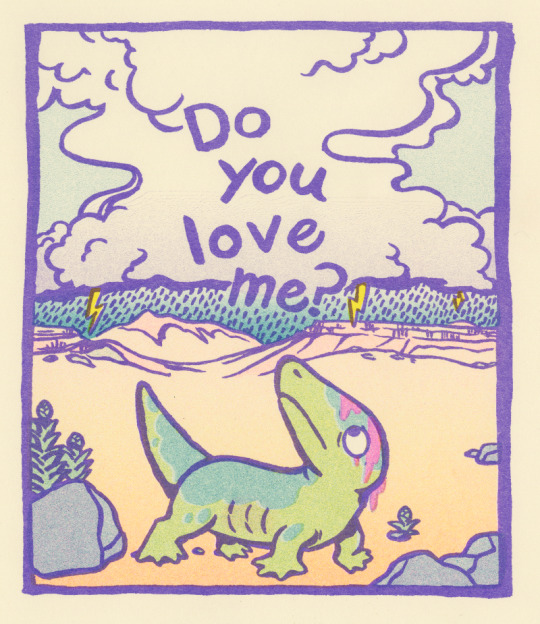
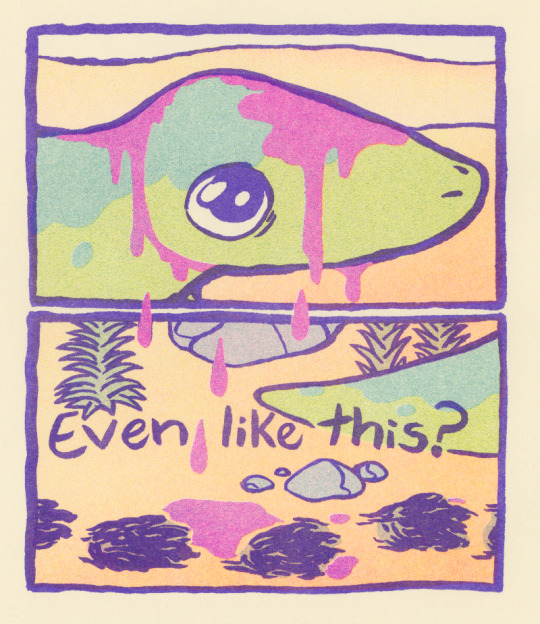
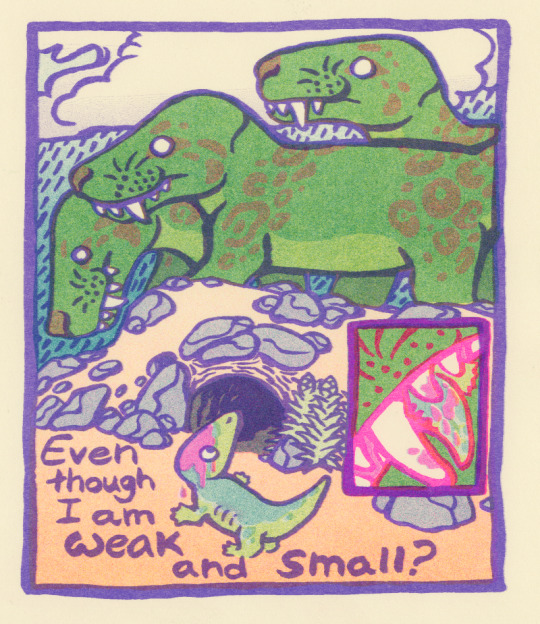
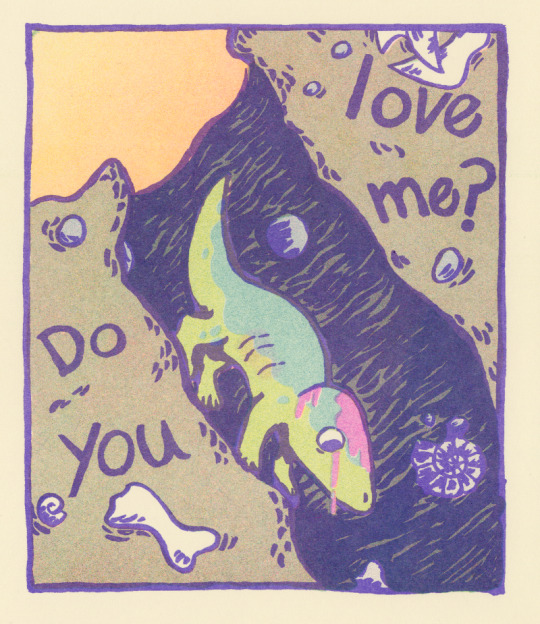

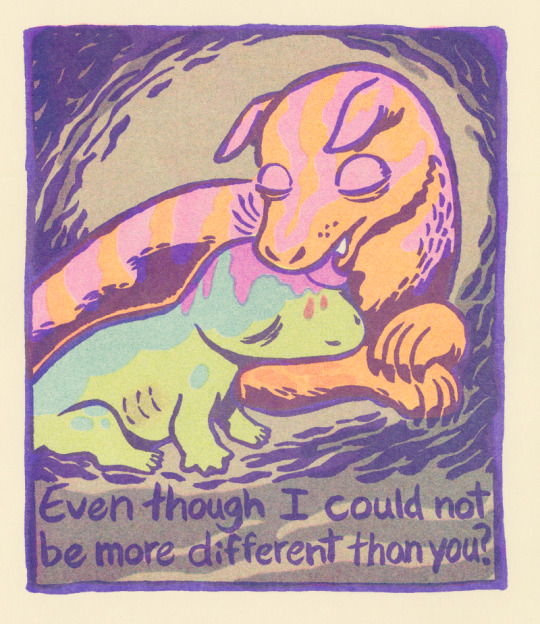
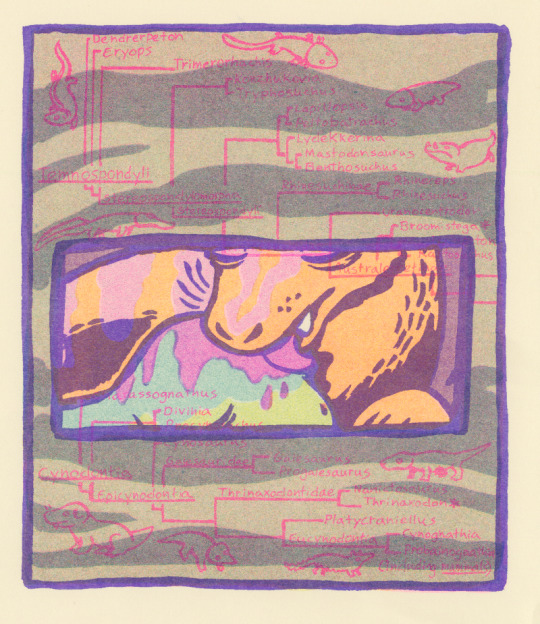
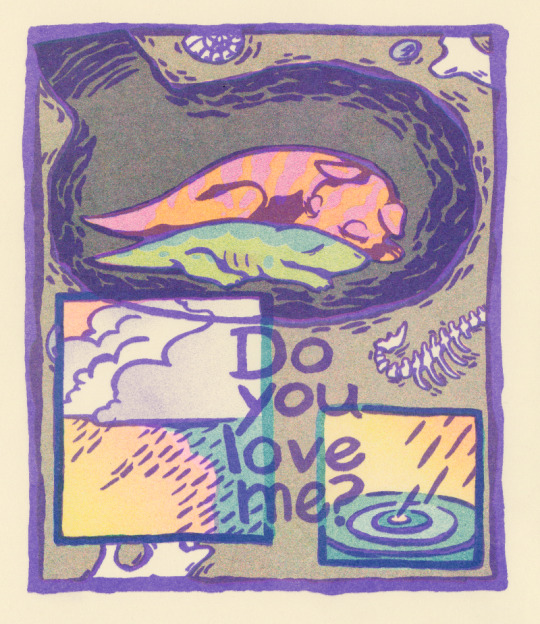


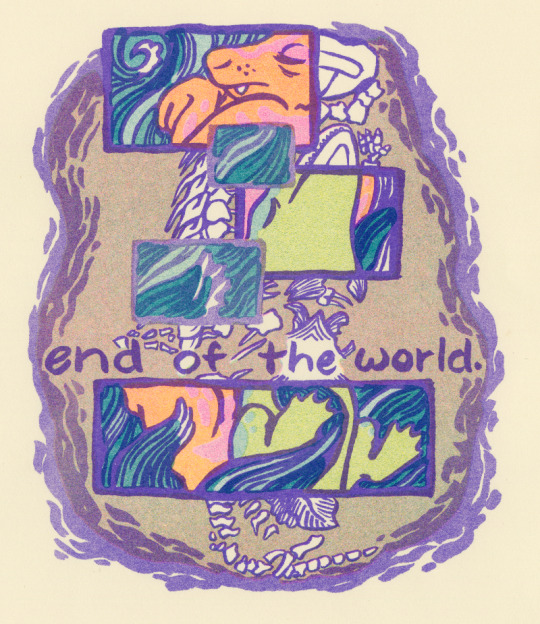

Hello, today is my birthday, and I would like to share a comic I made in the last year with you. It's called Broomistega and Thrinaxodon.
This comic was originally printed with yellow, fluorescent pink, light teal, and violet risograph inks. Physical copies are available in my shop.
#my artwork#comics#paleoart#paleoblr#triassic cuddle#paleontology#broomistega#thrinaxodon#fossils#risograph#riso#minicomics#extinction
34K notes
·
View notes
Text

EXTINCTION - THE ENDLING
EXTINCTION is a fantasy / horror story about things that end. You can get it here as part of the Shortbox Comics Fair!
The Extinction PDF is screen-reader accessible.
4K notes
·
View notes
Text
United Nature: Belly Rubs

View On WordPress
#6 panel comic#belly rub#cat#cats#comic#dog#dogs#extinction#funny#giraffe#UN; United Nature#war and peas
2K notes
·
View notes
Text



"The Last Parrots" - fiber sculpture with found drawer by Carol Eckert
4K notes
·
View notes
Text

#memes#meme#shitposting#shitpost#pull the lever kronk#relatable#lol#funny#funny meme#funny memes#relatable meme#relatable memes#dank#dank meme#dank memes#extinction
7K notes
·
View notes
Text


Probably the most depressing example of a modernization change in Tokyo Mew Mew New…
#tokyo mew mew#tokyo mew mew new#enviornment#environmental#extinction#extinct animals#azure does a thing#luke don’t look
30K notes
·
View notes
Text
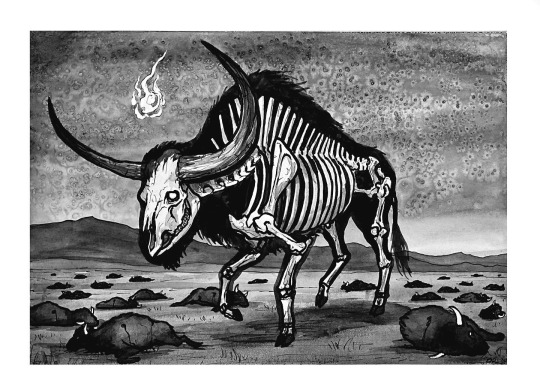
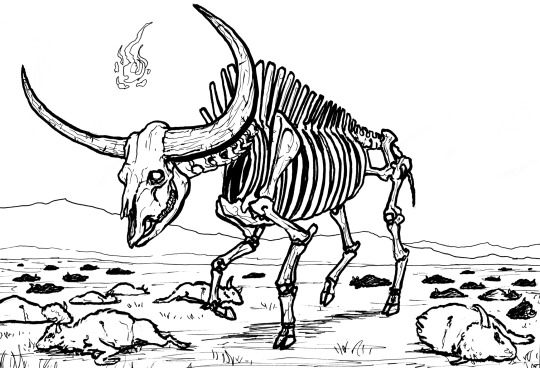
“Manifest Destiny”
Day 26 - Remove
One day the World will say, 'I am no more and I have nothing left to give.’
#illustration#my art#drawing#nature#inktober#western gothic#horror#watercolor#dark art#gothic americana#manifest destiny#extinction#macabre#prehistoric#steppe bison#art history#skeleton#surrealism#inktober 2023#bison
2K notes
·
View notes
Text

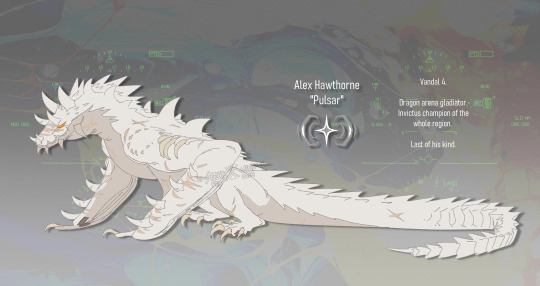
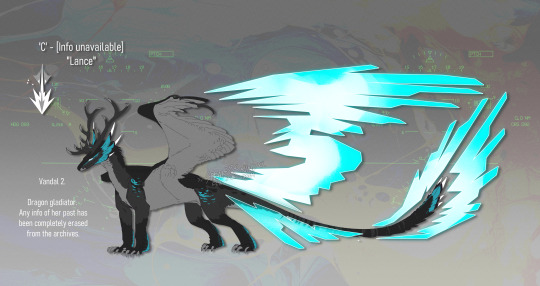

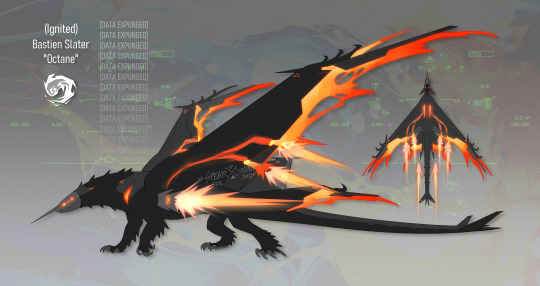
DEBRIEF/// [ VANDAL SQUADRON ]
#windyart#dragon#extinction#broken horizon#oc ref sheet#and in order of appearance#soleil#riptide#gala#alex#c#octane#HEY HI HELLO HERES MY GUYS!!!!!!!!!!!!!!!!!!!!!!!!!!!!!!!! i know no one follows me for anything like this anymore well.#im so sorryy this is my hyperfocus rn time for dragons and planes amen#I JUST THINK THEYRE NEAT
680 notes
·
View notes
Text

Feel like shit just want them back
#I'm not even joking i think about them on average at least once a day#i am unwell#passenger pigeon#we did you so so wrong#it's Makenna Is Mad About Extinct Birds hour again#martha i will avenge you#i don't know how yet but I'll do it#shut up me#extinction#extinct animals#birds#birdblr#environmentalism#i want to see them block out the sun i want to witness their splendor#but i can't and my soul will never know peace
759 notes
·
View notes
Text
So, I saw a post circulating here about the “extinction of birds in 2023“, with this picture attached
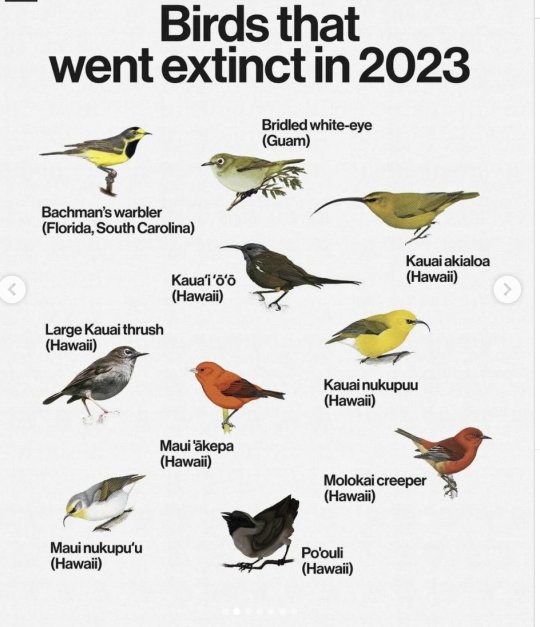
My, what a bold claim! All these poor birdies, “went extinct” in just one year alone? Why would such an outrageous, depressing and catchy claim be spread around?
Let’s fact check it.
All the species listed, Bachman’s wabler (Vermivora bachmanii, 1988 or 1980s), Kāmaʻo or large Kauaʻi thrush (Myadestes myadestinus, 1989 or 1987), Bridled white-eye (Zosterops conspicillatus, 1983 and 1983), Kauai ʻakialoa (Akialoa stejnegeri, 1969 or 1960s), Kauaʻi ʻōʻō (Moho braccatus, 1987 and 1987), Kauaʻi nukupuʻu (Hemignathus hanapepe, 1899 and 1899), Maui ʻakepa (Loxops ochraceus, 1988 and 1988), Kākāwahie or Molokaʻi creeper (Paroreomyza flammea, 1963 and 1963), Maui nukupuʻu (Hemignathus affinis, 1896* and 1996 ) and Poʻouli (Melamprosops phaeosoma, 2004 and 2004) are all, indeed, either extinct or possibly extinct, according to IUCN Red List of Threatened Species and U.S. Fish and Wildlife Service.
What are the dates after the scientific names? Well, those all are *last sightings* per IUCN Red List and USFWS accordingly. So, these birds were not seen for DECADES and in one case FOR MORE THAN A GODDAMN CENTURY. And sure as hell there is NO information about them very suddenly being gone all last year.
What’s the deal then? Where did this claim even come from? Well, likely from this article "21 Species Delisted from the Endangered Species Act due to Extinction" from U.S. Fish & Wildlife Service. It includes all the birds in the picture (with the last date of sight, listed above).
From the article: “The U.S. Fish and Wildlife Service is delisting 21 species from the Endangered Species Act due to extinction. Based on rigorous reviews of the best available science for each of these species, the Service determined these species are extinct and should be removed from the list of species protected under the ESA. Most of these species were listed under the ESA in the 1970s and 80s and were in very low numbers or likely already extinct at the time of listing.”
They didn’t ALL fucking suddenly drop dead all in the same year – if they did, as some other people have already pointed out, there would be an uproar EVERYWHERE. Ornithologists alone would not let it live down. They were officially delisted from endangered status by U.S. Fish & Wildlife Service that year, there was a proposition to do so back in 2021, too. Some were already declared extinct before by IUCN.
Despite not being seen for so long, they remained on the list of critically endangered for a long while, cause you cannot just immediately declare a species extinct. There’s no RTS unit amount number that goes to 0 once there’s nothing left; people keep checking for them over and over and over again. Sometimes it turns out that a species previously thought to be extinct is actually still out there. Attenborough's long-beaked echidna for example was last sighted SIXTY YEARS ago before being sighted again in 2023. It was thought to be extinct for a while, before 2007, when signs of its activity was spotted again. More often than not though, a species turns out to be actually very extinct, unfortunately – like in this case.
I cannot possibly know if the creators of this picture, or people that spread it on social media ever had good intentions behind it for awareness, however even if they did, it turned out to be nothing but very blatant misinformation, with a fearmongering effect. The only thing this achieves is not awareness of habitat destruction or pernicious tourist influence or climate change or what have you – the only thing this achieves is despair and panic. People already so casually fall into complete doomerism, they’re very used to hear bad news. And guess what doomerists do? Typically nothing. It renders people helpless. It’s not gonna make people get up and be ready for action, it, at best, would just make people feel sad and/or angry, or at worst, feed into the current alarming rise of ecofascism. NOTHING good comes out of this. At the very goddamn least, no one needs to lie to promote a goal.
The aim of the USFWS article, on the other hand, IS to make people aware about those animals that are already gone from the face of the planet, no matter how long ago, and that now we have to protect those animals that are critically endangered and still out there – to not have to repeat those tragedies.
Be very critical of what you see on the internet, especially if it’s sited with no sources. Especially-especially if it causes a strong emotional reaction. Lies and misinfo could only hurt the cause, no matter how noble. And please, be aware of your local wildlife status. Check in with it accoding to trusted sources.
[*sic, possibly a typo and it was meant to be 1996, other confirmed date listed there is 1989]
Addendum: I could not for sure find the uncredided (who woulda thunken that ppl that don't cite their sources would also not credit the artists) author(s) of the bird illustrations. If someone finds them, please, let me know!
Edit: Huge thanks to moosefinch for finding the sources for the artwork! I'll add their contribution below:
"Image sources!
The Kauai ʻakialoa, Kauaʻi ʻōʻō, Maui ʻakepa and Kauaʻi nukupuʻu are from Birds of the World.
The "Maui nukupuʻu" and "Molokaʻi creeper" illustrations are also Birds of the World, but are actually a female Kauaʻi nukupuʻu (the other being the male) and Laysan honeycreeper/Laysan ʻapapane respectively.
The bridled white-eye is by Lauren Helton according to this source.
Bachman's warbler is by Lynn Hawkinson Smith/smithhouse2 according to this Etsy listing.
The Poʻouli is by Christina Czajkowski."
#ah I just now see that the tumblr reblog of the pic and the twitter thread attached was deleted#yet the post is still in circulation. The damage lingers#so fucking irresponsible#fact check#misinformation#birds#bird#ecology#environmentalism#extinction#conservation#species conservation#animals#hawaiʻi#important
805 notes
·
View notes
Text
That's so cool! And they found a few of them, and they're now growing seedlings in greenhouses for eventual replanting!
Quercus tardifolia is a relic species leftover from when the climate was much cooler and wetter in the past, and can only really live in a few high-elevation spots in Texas. It's definitely still at risk of extinction due to increasing heat and drought caused by climate change, but the discovery means this species still has a chance.
#oak#oak trees#Quercus#Quercus tardifolia#Lazarus species#endangered species#extinction#trees#plants#botany#nature#climate change#global warming
4K notes
·
View notes
Text
"A 2019 sighting by five witnesses indicates that the long-extinct Javan tiger may still be alive, a new study suggests.
A single strand of hair recovered from that encounter is a close genetic match to hair from a Javan tiger pelt from 1930 kept at a museum, the study shows.
“Through this research, we have determined that the Javan tiger still exists in the wild,” says Wirdateti, a government researcher and lead author of the study.
The Javan tiger was believed to have gone extinct in the 1980s but only officially declared as such in 2008...
Ripi Yanuar Fajar and his four friends say they’ll never forget that evening after Indonesia’s Independence Day celebration in 2019 when they encountered a big cat roaming a community plantation in Sukabumi, West Java province.
Immediately after the brief encounter, Ripi, who happens to be a local conservationist, reached out to Kalih Raksasewu, a researcher at the country’s National Research and Innovation Agency (BRIN), saying he and his friends had seen either a Javan leopard (Panthera pardus melas), a critically endangered animal, or a Javan tiger (Panthera tigris sondaica), a subspecies believed to have gone extinct in the 1980s but only officially declared so in 2008.
About 10 days later, Kalih visited the site of the encounter with Ripi and his friends. There, Kalih found a strand of hair snagged on a plantation fence that the unknown creature was believed to have jumped over. She also recorded footprints and claw marks that she thought resembled those of a tiger.
Kalih then sent the hair sample and other records to the West Java provincial conservation agency, or BKSDA, for further investigation. She also sent a formal letter to the provincial government to follow up on the investigation request. The matter eventually landed at BRIN, where a team of researchers ran genetic analyses to compare the single strand of hair with known samples of other tiger subspecies, such as the Sumatran tiger (Panthera tigris sumatrae) and a nearly century-old Javan tiger pelt kept at a museum in the West Java city of Bogor.
“After going through various process of laboratory tests, the results showed that the hair sample had 97.8% similarities to the Javan tiger,” Wirdateti, a researcher with BRIN’s Biosystemic and Evolutionary Research Center, said at an online discussion hosted by Mongabay Indonesia on March 28.
The discussion centered on a study published March 21 in the journal Oryx in which Wirdateti and colleagues presented their findings that suggested that the long-extinct Javan tiger may somehow — miraculously — still be prowling parts of one of the most densely populated islands on Earth.
Their testing compared the Sukabumi hair sample with hair from the museum specimen collected in 1930, as well as with other tigers, Javan leopards and several sequences from GenBank, a publicly accessible database of genetic sequences overseen by the U.S. National Institutes of Health.
The study noted that the supposed tiger hair had a sequence similarity of 97.06% with Sumatran tigers and 96.87% with Bengal tigers. Wirdateti also conducted additional interviews with Ripi and his friends about the encounter they’d had.
“I wanted to emphasize that this wasn’t just about finding a strand of hair, but an encounter with the Javan tiger in which five people saw it,” Kalih said.
“There’s still a possibility that the Javan tiger is in the Sukabumi forest,” she added. “If it’s coming down to the village or community plantation, it could be because its habitat has been disturbed. In 2019, when the hair was found, the Sukabumi region had been affected by drought for almost a year.” ...
Didik Raharyono, a Javan tiger expert who wasn’t involved in the study but has conducted voluntary expeditions with local wildlife awareness groups since 1997, said the number of previous reported sightings coupled with the new scientific findings must be taken seriously. He called on the environment ministry to draft and issue a policy on measures to find and conserve the Javan tiger.
“What’s most important is the next steps that we take in the future,” Didik said."
-via Mongabay, April 4, 2024
#tigers#tiger#endangered species#extinction#conservation#environment#extinct animals#de extinction#indonesia#java#big cats#wild animals#good news#hope
615 notes
·
View notes
Text
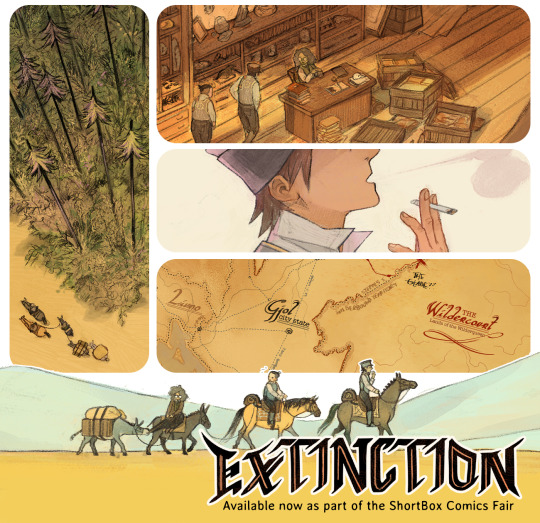
EXTINCTION - THE TRAVEL
EXTINCTION is a fantasy / horror story about things that end. You can get it here as part of the Shortbox Comics Fair!
The Extinction PDF is screen-reader accessible.
1K notes
·
View notes
Text
Only Skeletons

View On WordPress
#After humans#beach#comic#comic strip#extinct#extinction#funny#humanity#humans#humor#lol#planet earth#Skeletons#Spin the bottle#war and peas#webcomic
2K notes
·
View notes
Text


This 36x48” oil on canvas diptych is part of a series I’ve been working on based on the thylacine, also known as the “Tasmanian Tiger” or marsupial wolf.
One of my biggest interests has always been animals, and in particular the ones that humans have destroyed. Every lost or vanishing species is its own story, and as an illustrator theirs are the stories that I am the most invested in telling (hence the blog).
The thylacine is one of the classic examples of human-caused extinction: an utterly unique creature, deliberately exterminated due to a combination of greed, ignorance, hubris, and fear.
Scared or anxious marsupials have a habit of stretching their jaws in a display known as a yawn (you’ve probably seen memes of opossums that look like they’re yelling—it’s the same thing). This display was especially striking in the thylacine, which could open its jaw to over 90°. Some of the most famous photos of thylacines capture them in this attitude of fear.
Unfortunately for the thylacine, humans have more direct methods of dealing with the things that scare them.
The title of this pair of paintings is ‘When They Are Frightened, They Show Their Teeth’.
The overall series is called ‘Here Be Monsters’, as a nod to both the far-flung environs of the thylacine, and the behavior of those who intruded upon it.
Stay tuned for more.
#extinction#extinct#extinct animals#thylacine#tasmanian tiger#oil painting#animal illustration#extinct species#extinction stories
2K notes
·
View notes